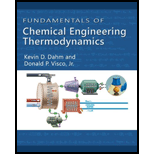
(A)
Interpretation:
Determine the work and heat transfer for this process.
Concept Introduction:
An energy balance equation piston cylinder arrangement.
Here, mass of the system is
Here, the height, velocity, shaft work is zero.
Rewrite the above steady state equation.
Here, initial specific internal energy is
The expression to calculate the change in enthalpy.
Here, derivative of specific enthalpy is
Write the expression to calculate the constant pressure heat capacity
Here, gas constant is
Substitute
Integrate the above Equation with respect to initial and final condition.
Here, final specific enthalpy is
Write the expression to calculate final specific volume
Here, final density is
Write the expression to calculate initial specific volume
Here, initial density is
Write the relation between the enthalpy and internal energy.
Here, enthalpy is
Write the expression to calculate the initial volume
Write the expression to calculate the work addition
Here, final volume is
Write the expression to calculate the final volume
Here, mass of liquid water is
(A)
Explanation of Solution
Calculate the change in enthalpy.
Refer the appendix table D.1, “Ideal Gas Heat Capacity”, obtain the constant values of water.
| Name | Formula | A | ||
| Water |
Substitute 8.712 for A,
Calculate the change in final specific volume
Substitute
Calculate the change in initial specific volume
Substitute
Write the relation between the enthalpy and internal energy.
Substitute
Calculate the final volume
Substitute
Calculate the initial volume
Substitute
Calculate the work addition.
Substitute
Thus, the work
Write the modified steady state equation.
Substitute
Thus, the heat
(B)
Interpretation:
Determine the heat transfer of the process.
Concept Introduction:
Write the expression to calculate the net specific enthalpy.
Write the expression to calculate final specific volume
Write the expression to calculate initial specific volume
Here, initial density is
Write the expression to calculate the final volume
Write the expression to calculate the initial volume
(B)
Explanation of Solution
Given information:
Density = 1000 g/L.
Calculate the net specific enthalpy.
Substitute
Assume that the net specific internal energy is equal to net specific enthalpy.
Substitute
Calculate the final specific volume
Substitute
Calculate the initial specific volume
Substitute
Calculate the final volume
Substitute
Calculate the initial volume
Substitute
Substitute
Substitute
Thus, the heat
(C)
Interpretation:
Compare the heat transfer values from part A and part B and verify the given process is legitimate and practical.
(C)
Explanation of Solution
The amount of heat transfer in part (A) is
Want to see more full solutions like this?
Chapter 3 Solutions
Fundamentals of Chemical Engineering Thermodynamics (MindTap Course List)
 Introduction to Chemical Engineering Thermodynami...Chemical EngineeringISBN:9781259696527Author:J.M. Smith Termodinamica en ingenieria quimica, Hendrick C Van Ness, Michael Abbott, Mark SwihartPublisher:McGraw-Hill Education
Introduction to Chemical Engineering Thermodynami...Chemical EngineeringISBN:9781259696527Author:J.M. Smith Termodinamica en ingenieria quimica, Hendrick C Van Ness, Michael Abbott, Mark SwihartPublisher:McGraw-Hill Education Elementary Principles of Chemical Processes, Bind...Chemical EngineeringISBN:9781118431221Author:Richard M. Felder, Ronald W. Rousseau, Lisa G. BullardPublisher:WILEY
Elementary Principles of Chemical Processes, Bind...Chemical EngineeringISBN:9781118431221Author:Richard M. Felder, Ronald W. Rousseau, Lisa G. BullardPublisher:WILEY Elements of Chemical Reaction Engineering (5th Ed...Chemical EngineeringISBN:9780133887518Author:H. Scott FoglerPublisher:Prentice Hall
Elements of Chemical Reaction Engineering (5th Ed...Chemical EngineeringISBN:9780133887518Author:H. Scott FoglerPublisher:Prentice Hall
 Industrial Plastics: Theory and ApplicationsChemical EngineeringISBN:9781285061238Author:Lokensgard, ErikPublisher:Delmar Cengage Learning
Industrial Plastics: Theory and ApplicationsChemical EngineeringISBN:9781285061238Author:Lokensgard, ErikPublisher:Delmar Cengage Learning Unit Operations of Chemical EngineeringChemical EngineeringISBN:9780072848236Author:Warren McCabe, Julian C. Smith, Peter HarriottPublisher:McGraw-Hill Companies, The
Unit Operations of Chemical EngineeringChemical EngineeringISBN:9780072848236Author:Warren McCabe, Julian C. Smith, Peter HarriottPublisher:McGraw-Hill Companies, The





